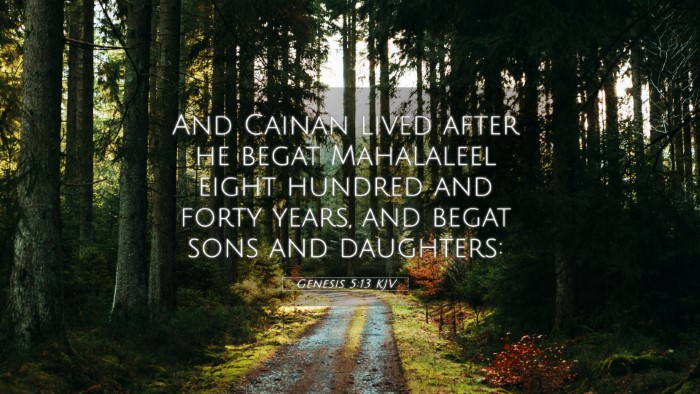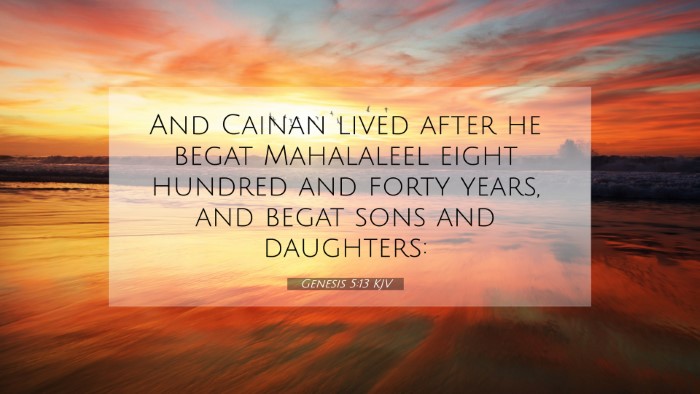Understanding Genesis 5:13
Genesis 5:13 reads: "And the days of Mahalalel were eight hundred ninety and five years: and he died." This verse is a part of the genealogy that traces the lineage from Adam to Noah, highlighting the lifetime of Mahalalel, showing the longevity of life during early biblical history.
Insights from Public Domain Commentaries
This verse, while brief, offers significant insights when examined through various commentaries:
-
Matthew Henry comments on the whole genealogical record, indicating that each name in the genealogy serves to demonstrate God's covenant with humanity and His promise to preserve a remnant. Mahalalel's long life exemplifies God's mercy and grace, allowing ample opportunity for repentance and faithfulness.
-
Albert Barnes emphasizes the historical context, noting that the ages of the patriarchs serve not only to illustrate their physical longevity but also to underscore the reality that they were fulfilling God's purposes on earth. Each name and year represents a span of God’s providential care and purpose.
-
Adam Clarke discusses the meaning behind Mahalalel’s name, translating it as "the blessed God" or "praise of God." This interpretation invites deeper reflection on the life lived in connection to God and the character of the lives of these early ancestors of humanity.
Bible Verse Cross-References
Genesis 5:13 connects with several important biblical themes and verses:
- Genesis 2:17 — The consequence of sin and death, which relates to the eventual death of Mahalalel.
- Genesis 4:26 — The introduction of calling upon the name of the Lord, highlighting the spiritual context of these patriarchs.
- Hebrews 11:5 — An examination of faith where Enoch’s walking with God is paralleled, drawing attention to the patriarchs’ relationship with God.
- Luke 3:37-38 — The genealogy of Jesus, which retraces the lineage from Adam to Christ, showing the importance of these early figures.
- Romans 5:12 — The connection between sin and death introduced through Adam, which relates to the death ultimately experienced by all, including Mahalalel.
- 1 Peter 3:20 — Notes the patience of God during the days of Noah, which reflects on the extended lifespans of the antediluvian patriarchs.
- Jude 14 — References Enoch, as a bridge between the genealogies, emphasizing the significance of aligning with God’s will.
Thematic Bible Verse Connections
The mention of Mahalalel's lifespan can also be connected to broader themes in Scripture that address:
- Life and Death: The essence of life as a gift from God and the unavoidability of death due to sin.
- God’s Promises: How God’s long-suffering relates to humanity's opportunity to turn towards Him.
- Genealogy and Legacy: The significance of lineage in God's redemptive plan, culminating in the Messiah.
How to Use Bible Cross-References
The study of Genesis 5:13 can provide valuable lessons on how to engage in cross-referencing within Scripture:
- Identify key themes such as longevity and faithfulness that appear throughout the Bible.
- Utilize tools like a Bible concordance to find relevant cross-references that enhance your understanding.
- Engage in comparative Bible verse analysis to uncover connections between different biblical texts.
- Look into traditional commentaries and modern studies for deeper insight into these themes.
Conclusion
Genesis 5:13 serves as a reminder of the faithfulness of God throughout generations. By using the tools of cross-referencing and reflecting on the lives of these early figures, we can appreciate the continuity of God’s work in history. The connections made through these scriptures provide a rich tapestry of God's purpose, inviting believers to consider their own legacies in light of His promises.


